Picture the moment: The final whistle blows on a state championship game. Players rush the field in celebration. Coaches embrace with tears of joy. Parents cheer from the stands. The student section erupts. The championship trophy gleams under the stadium lights. This culmination of months—or years—of dedication, early morning practices, weekend sacrifices, and unwavering commitment deserves to be remembered, celebrated, and preserved.
Yet many schools struggle to give state championships the lasting recognition these achievements deserve. Physical trophy cases fill quickly with decades of awards. Championship banners compete for limited ceiling space. Traditional plaques provide only basic information about the triumph. And within weeks, the intensity of celebration fades as the school year continues and new sports seasons begin.
Modern recognition solutions address these challenges while transforming how schools celebrate fall sports state championships. Digital displays, interactive touchscreen systems, and comprehensive recognition programs ensure that championship achievements receive permanent, engaging celebration that inspires current students, connects alumni, and builds lasting school pride around athletic excellence.
Understanding Fall Sports Championship Season
Before exploring recognition strategies, understanding the scope and significance of fall sports state championships provides essential context for implementation planning.
The Fall Sports Championship Landscape
Fall sports encompass diverse athletic competitions across various sports, each with unique championship structures and competitive traditions.
Major Fall Sports Championships:
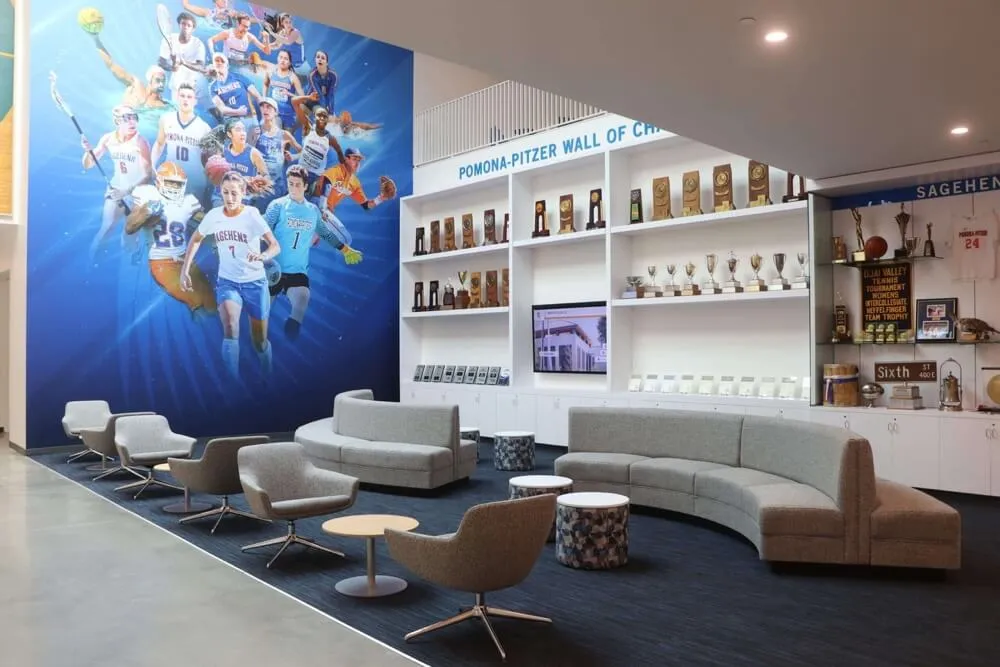
Football Championships: The marquee fall sport in many states, with classification-based state championships typically held in November and December. States may conduct championships across 5-8 classifications based on school enrollment, ensuring competitive balance while providing championship opportunities for schools of all sizes. Championship games often occur at neutral-site college or professional stadiums, creating memorable experiences for players and fans.
Volleyball Championships: Most states conduct both girls’ volleyball (fall season in most regions) and boys’ volleyball (typically spring) championships. Tournament formats usually include regional qualifiers leading to state tournament finals. The sport’s multiple classification levels ensure that schools across different sizes compete equitably for state honors.
Soccer Championships: Both boys’ and girls’ soccer programs compete during fall seasons in most states, with championship tournaments culminating in November. Like other fall sports, soccer championships typically organize by classification, with larger schools competing separately from smaller schools to maintain competitive balance.
Cross Country Championships: One of fall’s most inclusive sports, with both individual and team state championships. Cross country uniquely recognizes both individual excellence (top finishers across the state) and team achievement (schools with best combined finishes), creating multiple celebration opportunities for exceptional programs.
Field Hockey Championships: Primarily concentrated in the Northeast and Mid-Atlantic states, field hockey championships represent significant achievements in regions with strong program traditions. These championships often feature intense competition among schools with decades-long rivalries and championship histories.
Championship Timing and Recognition Opportunities
Fall sports championships occur in compressed timeframes creating both opportunities and challenges for recognition planning.
Championship Season Timeline:
- Late October: Early playoff rounds begin for most fall sports
- November: State tournament brackets narrow toward championship games
- Late November/Early December: Most fall state championships conclude
- December: Recognition ceremonies, banquets, and permanent display updates
This concentrated timeline means schools should have recognition strategies planned in advance, enabling quick implementation when championships occur. Waiting until after championships to begin planning recognition often results in missed opportunities for timely celebration when excitement and community attention remain high.
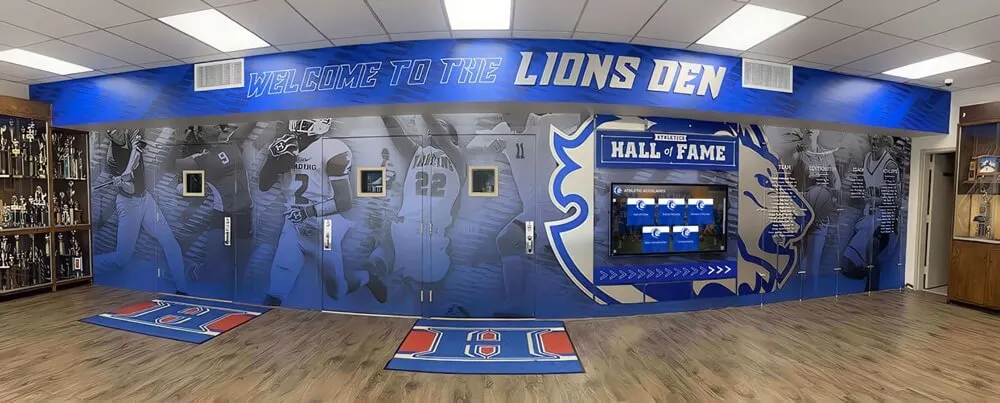
Why Fall Championships Merit Special Recognition
Fall sports championships hold particular significance within school athletic programs for several reasons that recognition programs should acknowledge.
Season-Opening Energy: Fall championships kick off the academic year’s competitive season, setting tone for school spirit and athletic department culture. Success in fall creates momentum carrying through winter and spring sports, building confidence and expectations throughout programs.
Community Engagement: Fall sports, particularly football, often generate greatest community attendance and involvement. Championships occurring during this high-visibility period create shared celebration moments that strengthen school-community connections and generate pride extending beyond athletic departments.
Senior Legacy: For many senior athletes competing in fall sports, state championships represent career-defining achievements and final opportunities to contribute to school athletic tradition. Recognition programs honoring these seniors demonstrate institutional appreciation while creating closure moments marking transitions from high school to post-secondary life.
Program Validation: State championships validate coaching excellence, training program quality, and long-term program development. Recognition should celebrate not just the championship team but the sustained effort, strategic planning, and consistent execution that enabled championship-level performance.
Traditional Championship Recognition Methods
Understanding established recognition approaches provides context for evaluating contemporary alternatives and identifying limitations that modern solutions address.
Physical Championship Trophies and Display Cases
Championship trophies represent tangible evidence of achievement that schools have displayed in trophy cases for generations.
Traditional Trophy Case Strengths:
- Immediate physical presence creating visible program celebration
- Tactile connection to achievement through physical objects
- Familiar format easily understood by all audiences
- Traditional aesthetic fitting established school architecture
- Permanent fixture requiring no technical maintenance
- Direct connection to championship moment through actual awarded trophy
Significant Trophy Case Limitations:
- Limited space forcing difficult decisions about which achievements to display
- Security concerns about valuable championship trophies in public spaces
- Deterioration of trophies and cases over time requiring maintenance
- Static presentation providing only basic championship information
- Difficulty updating or reorganizing as new championships accumulate
- Accessibility limited to those physically present at display location
- Dust accumulation and cleaning challenges with overhead cases
According to facilities managers surveyed across 200 high schools, traditional trophy cases typically accommodate 30-50 trophies. Schools with 15-20 sports generating championships across multiple classifications can exceed this capacity within 5-10 years, forcing removal of older trophies regardless of historical significance.
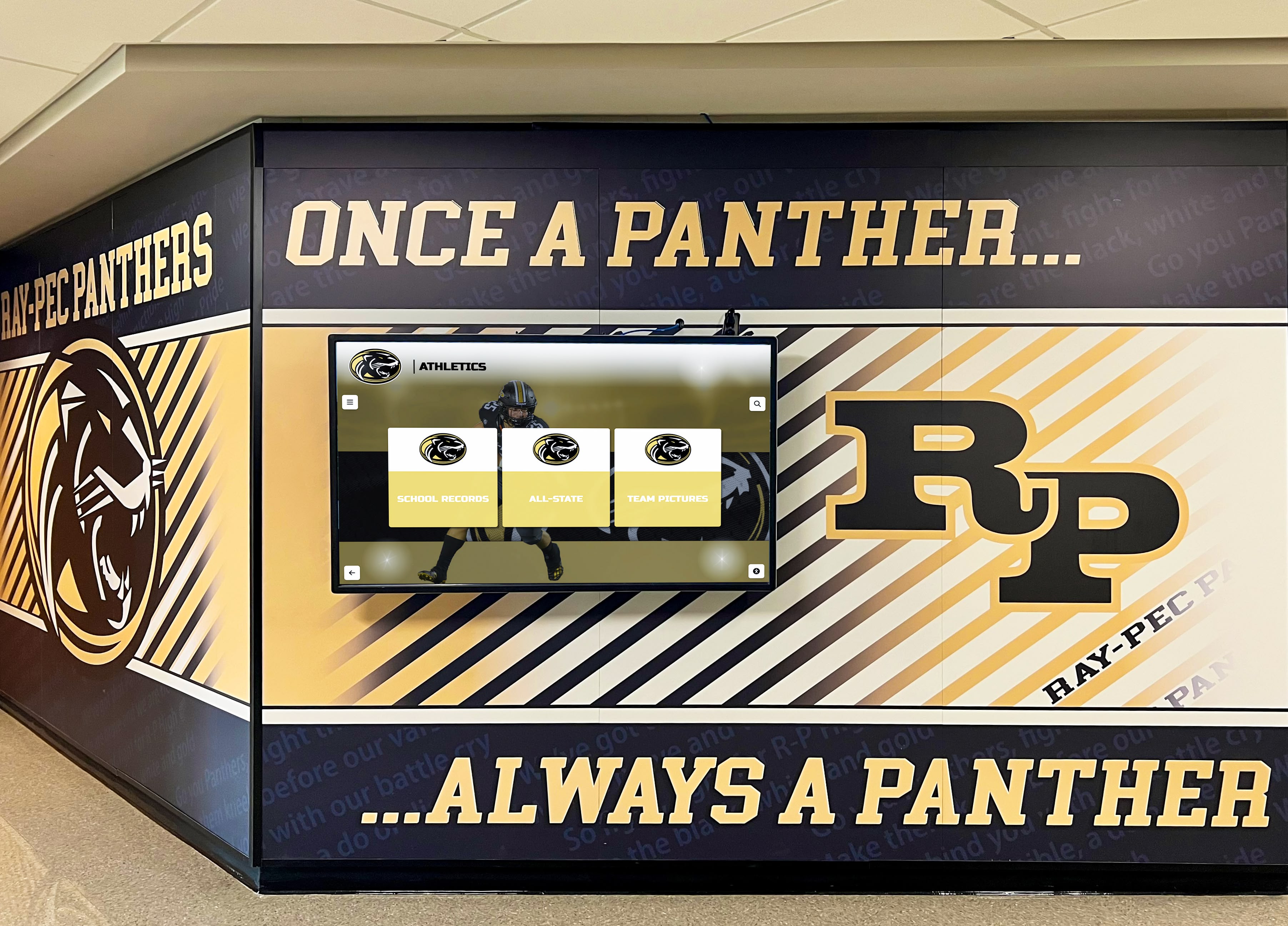
Championship Banners and Hanging Displays
Gymnasium banners represent another traditional approach, displaying championships prominently overhead where teams compete.
Banner Display Advantages:
- Highly visible during games when attendance and attention peak
- Create impressive visual impact in gymnasium settings
- Relatively affordable compared to other permanent recognition
- Can accommodate text information beyond simple trophy labels
- Establish physical championship presence in competition venues
- Build visual tradition as banners accumulate over successful years
Banner System Challenges:
- Ceiling space limitations as programs accumulate championships
- Height placement makes detailed information difficult to read
- Physical materials fade and deteriorate requiring replacement
- Installation and removal requires specialized equipment and labor
- Limited information capacity—typically just sport, year, classification
- Cannot include photos, statistics, rosters, or detailed achievement context
- Inflexible organization once hung—difficult to reorganize chronologically
Some schools implement rotating banner systems, displaying current achievements while storing older banners. However, this approach means significant championships remain invisible most of the time, undermining recognition’s inspirational and tradition-building value.
Printed Programs and Yearbook Recognition
Schools typically document championships in printed materials distributed to students and families.
Publication Recognition Benefits:
- Detailed information possible including complete rosters and statistics
- Professional photography capturing championship moments
- Distributed to students who receive personal copies
- Permanent printed record for historical documentation
- Academic year documentation preserving institutional memory
Publication Format Limitations:
- Limited distribution primarily to current year students and families
- Quickly becomes inaccessible once published and distributed
- Cannot update with subsequent information or achievements
- Minimal ongoing visibility after initial distribution
- Storage challenges as printed materials accumulate
- Expensive to produce and distribute annually
- Environmental concerns about paper consumption
While publications serve important documentation functions, they cannot provide the ongoing visibility and accessibility that effective championship recognition requires for maximum inspirational and community-building impact.
Modern Digital Championship Recognition Solutions
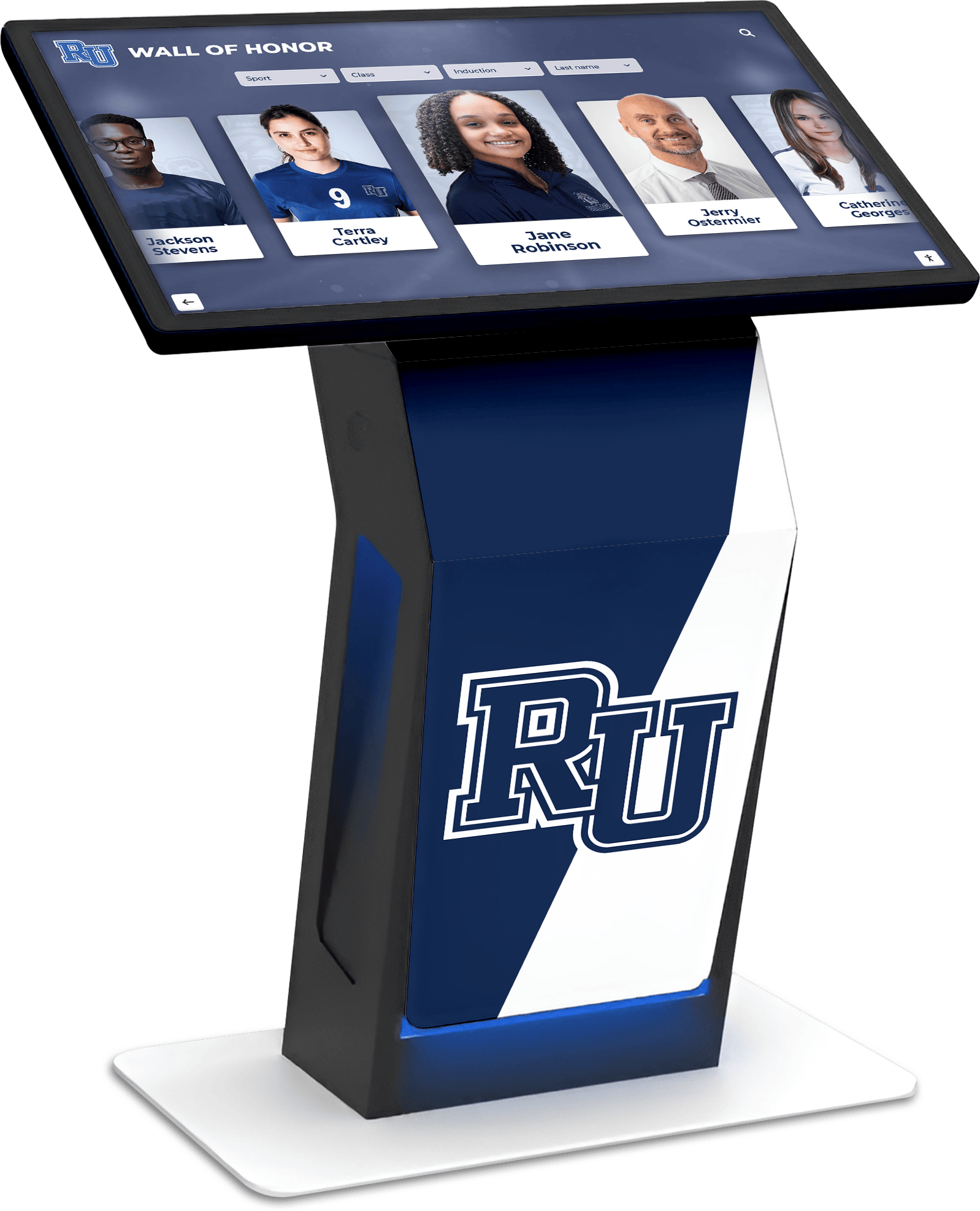
Digital recognition technology eliminates traditional approach limitations while introducing capabilities that fundamentally transform how schools celebrate fall sports state championships.
Interactive Touchscreen Championship Displays
Modern digital systems combine commercial-grade touchscreen hardware with specialized software designed specifically for athletic championship recognition.
Core Technology Components:
Display Hardware:
- Commercial touchscreen displays (43-75 inches) providing crisp, engaging presentations
- Industrial-grade components rated for continuous operation (50,000-70,000 hours)
- Wall-mounted or freestanding kiosk configurations adapting to various facility layouts
- High-resolution panels (1080p or 4K) ensuring text clarity and image quality
- Responsive multi-touch interfaces supporting natural interaction
- Tempered glass surfaces resisting damage in high-traffic environments
Recognition Software Platform:
- Cloud-based content management enabling updates from any internet-connected device
- Intuitive interfaces requiring no technical expertise for athletic staff
- Purpose-built templates designed for championship documentation
- Searchable databases allowing instant athlete, team, or year lookup
- Multimedia integration supporting photos, videos, and extended narratives
- Automatic content rotation featuring different championships and athletes
- Analytics tracking engagement patterns and popular content
- Mobile-responsive versions extending access beyond physical displays
Solutions like Rocket Alumni Solutions provide turnkey platforms specifically optimized for school athletic recognition, eliminating customization work required by generic digital signage alternatives.
Unlimited Recognition Capacity
Perhaps the most transformative advantage: unlimited capacity for recognizing achievements without physical space constraints.
Capacity Benefits:
- Document every championship across all fall sports and classifications
- Include complete team rosters with individual athlete profiles
- Preserve championship game details, statistics, and memorable moments
- Add unlimited photos from regular season, playoffs, and championship celebrations
- Incorporate video highlights from championship games
- Maintain historical championships from program founding through present
- Recognize both team achievements and individual all-state selections
- Document coaching contributions to championship success
A single 55-inch touchscreen can showcase comprehensive documentation for hundreds of championships—content requiring dozens of physical trophy cases to display. Schools finally recognize every championship team and contributing athlete regardless of when achievements occurred, ensuring comprehensive celebration honoring complete program history.
Rich Multimedia Championship Storytelling
Digital platforms enable recognition depth impossible with traditional static displays, transforming basic championship acknowledgment into compelling stories that engage viewers emotionally.
Multimedia Content Types:
Championship Game Coverage:
- Video highlights showing key plays and game-winning moments
- Final score and game statistics documentation
- Championship game program and newspaper coverage
- Photo galleries from pregame, competition, and celebration
- Radio or television broadcast clips when available
Team Documentation:
- Complete roster with player names, numbers, positions, and classes
- Team photos showing championship squad
- Individual athlete photos and biographical information
- Season statistics and achievements leading to championship
- Regular season and playoff game results and scores
Behind-the-Scenes Content:
- Practice footage showing preparation and team development
- Coach interviews discussing strategy and team building
- Player testimonials reflecting on championship experience
- Parent and community perspectives on championship significance
- Locker room celebration footage capturing authentic emotion
Historical Context:
- Program history showing path to championship success
- Comparison to previous championship teams
- Significance within conference or state competitive landscape
- Connection to school and community traditions
- Alumni success stories from championship team members
This multimedia richness creates emotional connections that simple championship banners or trophy labels cannot generate, transforming recognition into engaging storytelling that preserves championship memories comprehensively.
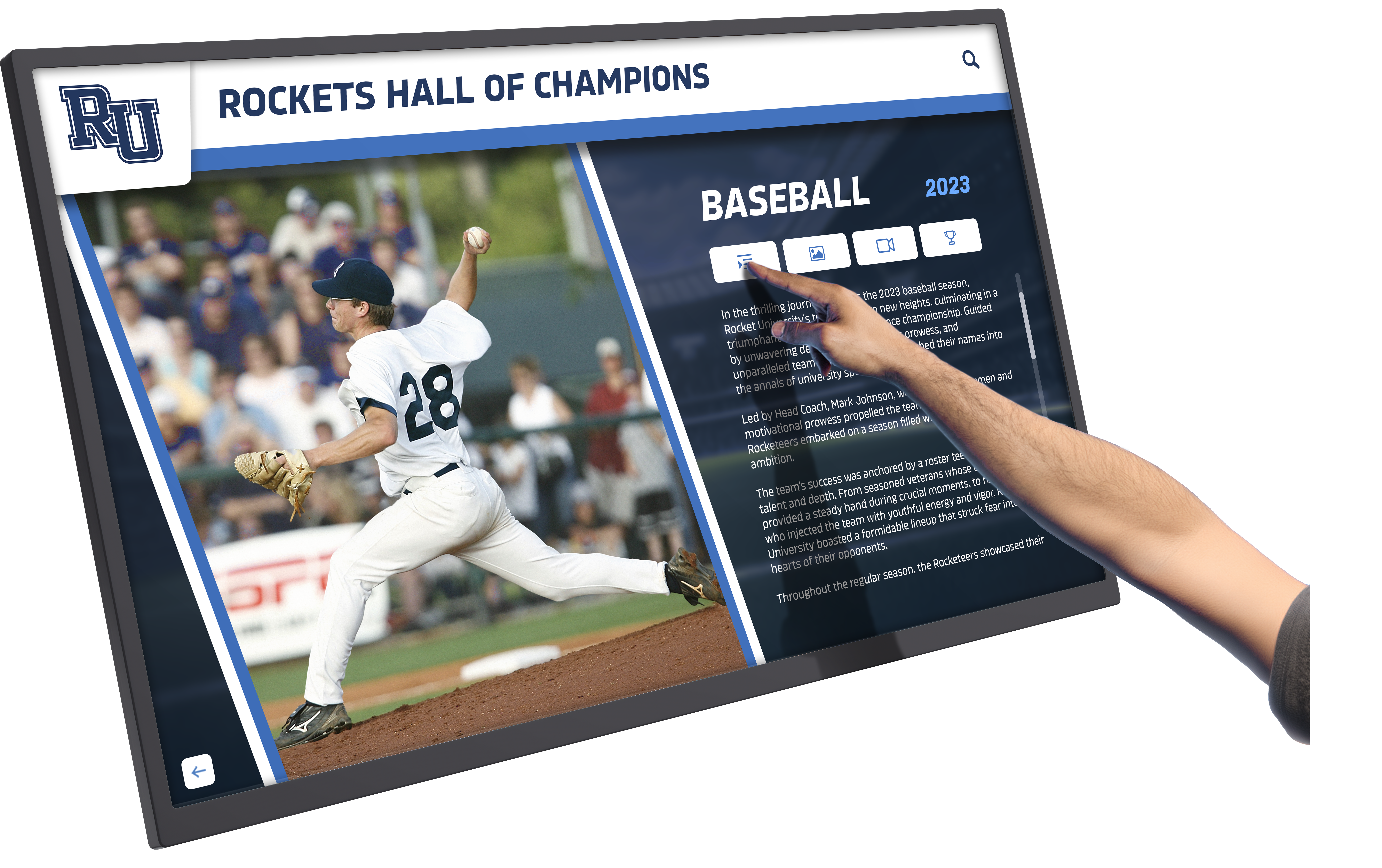
Interactive Search and Exploration Features
Digital systems enable visitors to actively engage with championship content through intuitive navigation that transforms passive viewing into participatory experiences.
Interactive Capabilities:
Search Functions:
- Name-based search finding specific athletes instantly across all championships
- Year-based search locating championships from particular seasons
- Sport filtering showing only football, volleyball, soccer, or other specific sports
- Classification filtering for schools competing in multiple divisions
- Position or role filtering within team rosters
- Coach search connecting championships to coaching leadership
Discovery Features:
- Related championship connections (athletes competing in multiple sports)
- “On This Day” features highlighting historical championships
- Decade-by-decade browsing showing program evolution
- Comparison tools showing statistics across different championship teams
- Timeline views presenting championships chronologically
- Random championship profiles introducing unexpected discoveries
Social and Sharing Features:
- QR codes linking to extended online championship profiles
- Social media sharing buttons distributing championship recognition
- Email options sending championship information to personal addresses
- Print features creating take-home championship documentation
- Mobile app integration extending access beyond physical displays
Schools implementing interactive systems report that visitors spend 6-8 times longer exploring digital displays featuring video and search capabilities compared to traditional static trophy cases. This extended engagement creates stronger emotional connections and more meaningful recognition experiences.
Sport-Specific Fall Championship Recognition
Different fall sports present unique championship characteristics that recognition programs should acknowledge through tailored approaches.
Football State Championships
Football championships often represent high-profile achievements receiving extensive community attention and media coverage.
Football-Specific Recognition Elements:
Game Documentation:
- Championship game video highlights featuring key plays
- Complete game statistics for both teams
- Scoring summary showing touchdown drives and key moments
- Weather conditions and stadium atmosphere details
- Attendance figures and crowd energy descriptions
- Radio broadcast clips and commentary excerpts
Player Recognition:
- Offensive and defensive unit rosters
- Special teams contributors
- Position-specific achievements (rushing yards, passing statistics, tackles)
- All-state and all-conference selections from championship team
- Individual awards earned during championship season
- Post-high school football careers for team members
Coaching Recognition:
- Head coach career achievements and previous championships
- Assistant coach contributions and specializations
- Coaching staff photos and biographical information
- Game planning and strategic decisions enabling championship
- Coach testimonials about team development
Championship Context:
- Playoff bracket progression showing path to championship
- Scores and opponents defeated throughout playoff run
- Classification and competitive context
- Historical significance within program tradition
- Community celebration and recognition activities
Many schools integrate football championship recognition with broader student athlete recognition programs celebrating complete athletic achievement across multiple dimensions.
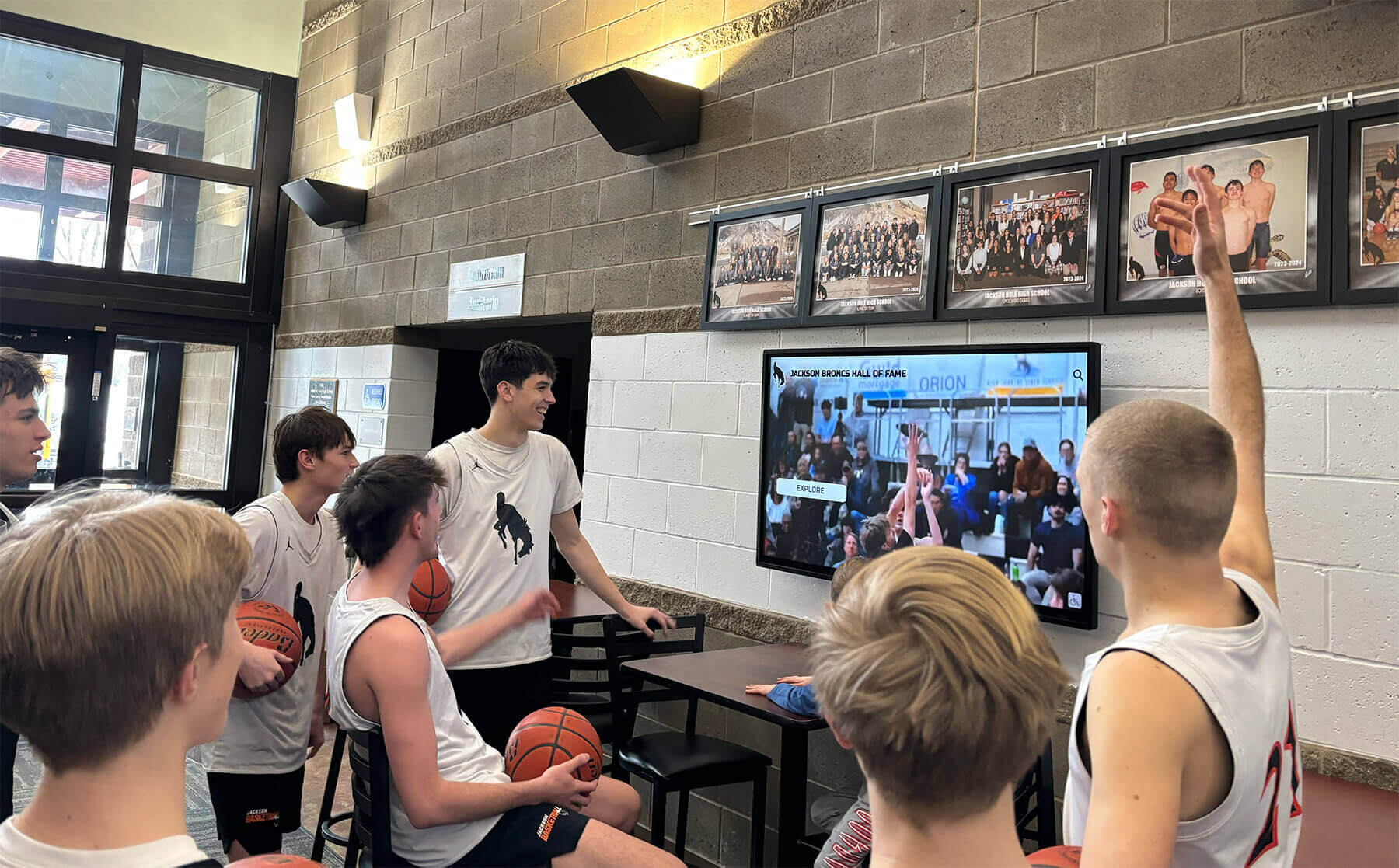
Volleyball State Championships
Volleyball championships demonstrate teamwork excellence and sustained performance across tournament play.
Volleyball-Specific Recognition:
Tournament Documentation:
- State tournament bracket progression
- Match-by-match results and set scores throughout tournament
- Statistical leaders in kills, assists, blocks, and digs
- Serving statistics and ace totals
- Defensive performance metrics
- Championship match highlights and key rallies
Team Recognition Elements:
- Starting lineup and rotation patterns
- Position-specific contributions (setters, outside hitters, middle blockers, liberos)
- Team chemistry and communication excellence
- Practice dedication and preparation
- Coach testimonials about team development
- Season journey from preseason through state championship
Individual Achievement:
- All-tournament team selections
- All-state honors earned during championship season
- Statistical achievement milestones
- College recruitment and commitments
- Post-high school volleyball careers
Soccer State Championships
Soccer championships showcase both team tactical excellence and individual skill across diverse positions.
Soccer-Specific Recognition:
Match Documentation:
- Championship game highlights featuring goals and key moments
- Complete match statistics (shots, possession, corners, saves)
- Scoring summary with assist credits
- Goalkeeper performance documentation
- Defensive excellence and shutout achievements
- Penalty kick results if applicable
Position Recognition:
- Goalkeeper achievements and save statistics
- Defensive unit recognition
- Midfield playmaking contributions
- Forward scoring and assist statistics
- Position-specific all-state selections
- Balanced team approach emphasizing all positions
Season Context:
- Regular season preparation building toward playoffs
- Conference tournament performance
- Playoff bracket progression
- Opponent quality and competitive context
- Weather and field conditions during championship
- Community support and attendance
Cross Country State Championships
Cross country offers unique dual recognition opportunities for both team and individual state championship achievements.
Cross Country-Specific Recognition:
Team Championship Documentation:
- Complete team scoring showing top finishers
- Team score and margin of victory
- Individual finish positions for all varsity runners
- Course records and notable times
- Championship course description and conditions
- Team celebration photos
Individual State Champions:
- Race highlights and finish line footage
- Winning time and margin of victory
- Seasonal progression showing performance improvement
- Training regimen and preparation approach
- Coach perspective on athlete development
- Comparison to historical state championship times
Program Depth Recognition:
- Complete varsity roster recognition beyond top scorers
- Junior varsity team contributions to program culture
- Training partners supporting championship runners
- Coaching staff contributions
- Program philosophy and training approach
Schools successfully implementing digital record boards often integrate individual and team cross country achievements within comprehensive athletic recognition systems.
Field Hockey State Championships
Field hockey championships represent significant achievements in regions with strong program traditions, particularly across the Northeast and Mid-Atlantic states.
Field Hockey-Specific Recognition:
Championship Game Documentation:
- Game highlights showing goals, saves, and key plays
- Statistical documentation (shots, corners, saves)
- Scoring summary with goal descriptions
- Goalkeeper performance recognition
- Defensive excellence acknowledgment
- Championship game conditions and atmosphere
Team and Individual Recognition:
- Complete roster with positions
- All-state and all-region selections
- Statistical leaders throughout season
- Senior leadership contributions
- Coaching staff recognition
- Historical program context
Implementing Comprehensive Fall Championship Recognition Programs
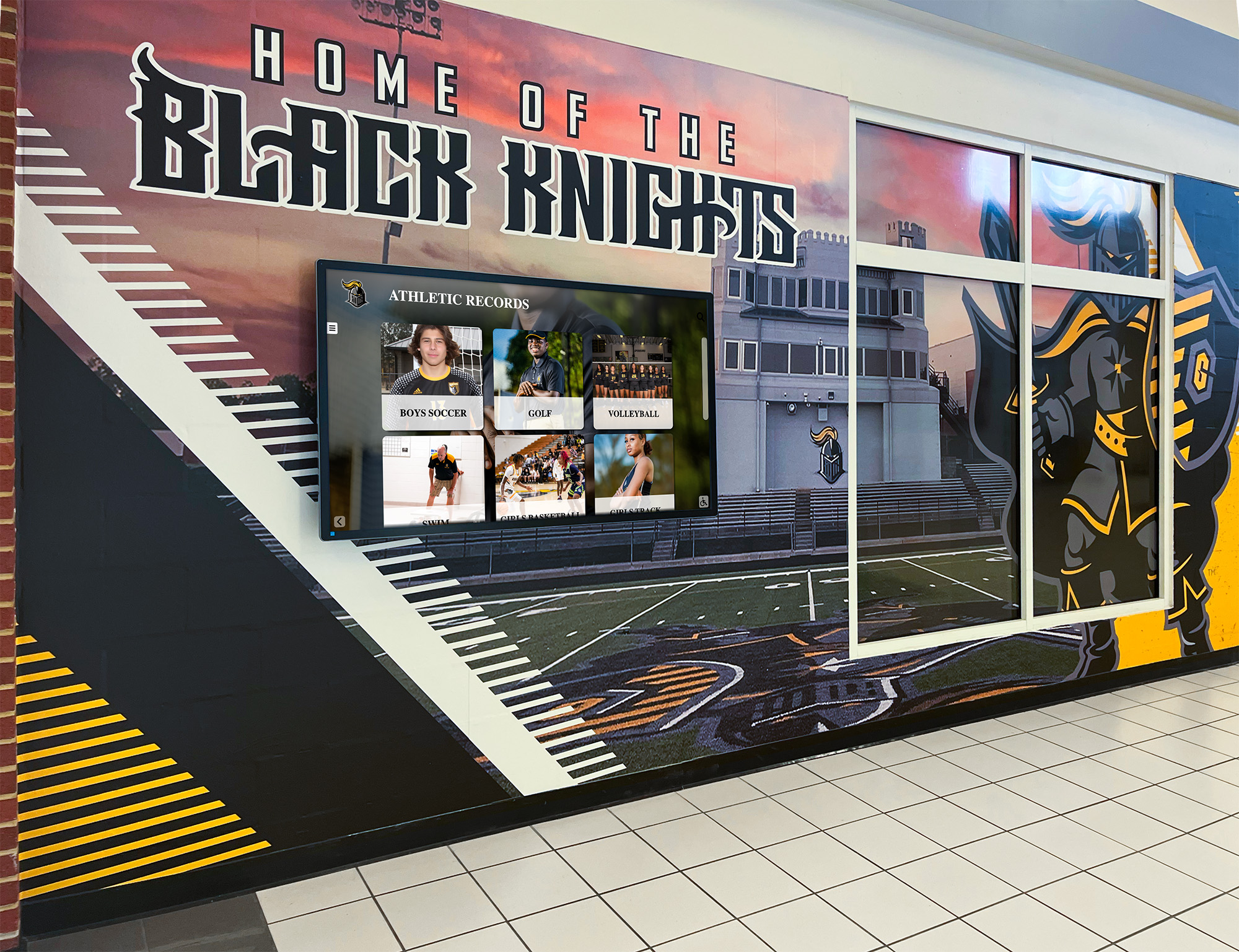
Successfully implementing championship recognition requires systematic planning addressing technology, content, timing, and community engagement.
Planning and Timeline Development
Begin recognition planning before championship seasons start, ensuring systems and processes enable timely celebration when championships occur.
Pre-Season Preparation:
- Evaluate existing recognition capabilities and limitations
- Identify technology needs and budget allocations
- Assign staff responsibilities for championship documentation
- Establish content collection workflows (photos, videos, statistics)
- Create templates for rapid championship profile development
- Coordinate with coaches about documentation priorities
- Plan recognition event schedules and formats
Championship Documentation Workflows:
- Designate photographers and videographers for championship coverage
- Establish statistical tracking and record-keeping processes
- Coordinate with media for access to broadcast coverage
- Plan trophy and banner ordering with adequate lead times
- Develop social media content calendars
- Prepare press release templates for customization
- Create parent and community communication plans
Post-Championship Recognition:
- Immediate social media celebration and announcements
- Championship profile creation and display updates within 48-72 hours
- Recognition ceremony planning within 1-2 weeks
- Permanent display updates completed within 2-3 weeks
- Season-ending banquet integration within 3-4 weeks
- Long-term archival and historical integration within season conclusion
Technology Selection and Installation
Choose recognition technology that aligns with program scale, budget, and long-term sustainability goals.
Hardware Considerations:
Display Size and Placement:
- 43-55 inch displays for intimate hallway locations with close viewing
- 55-75 inch displays for main gymnasium lobbies with group viewing
- Multiple displays distributed across athletic facilities for comprehensive coverage
- Strategic placement in high-traffic areas ensuring maximum visibility
- Professional mounting ensuring security and optimal viewing angles
Software Platform Requirements:
- Intuitive content management requiring minimal training
- Purpose-built recognition templates designed for championships
- Cloud-based access enabling remote content updates
- Multimedia support for videos, photos, and documents
- Search and filtering capabilities for interactive exploration
- Analytics providing engagement insights
- Mobile-responsive versions extending access beyond physical displays
Network and Infrastructure:
- Reliable internet connectivity (wired Ethernet preferred)
- Adequate electrical power at display locations
- Environmental considerations (temperature, humidity, lighting)
- Security measures protecting valuable hardware
- Maintenance access for cleaning and occasional service
Schools implementing comprehensive recognition systems should explore solutions like those from Rocket Alumni Solutions, which provide integrated platforms specifically designed for educational athletic programs.
Content Development Strategies
Compelling championship recognition requires systematic content collection, organization, and presentation.
Essential Championship Content:
Visual Assets:
- Professional team photos taken after championship games
- Action photography from championship competition
- Trophy presentation and celebration photos
- Locker room celebration footage
- Community celebration and parade photos
- Coach and senior athlete portraits
Written Documentation:
- Complete roster with accurate name spellings
- Player positions, numbers, and class years
- Season statistics and records
- Championship game summary and highlights
- Coach quotes and reflections
- Player testimonials about championship experience
Video Content:
- Championship game highlights (2-3 minutes)
- Celebration footage capturing authentic emotion
- Coach interviews conducted shortly after championship
- Senior athlete reflections on championship significance
- Behind-the-scenes practice or preparation footage
- Community reaction and celebration coverage
Statistical and Historical Context:
- Complete season results and statistics
- Playoff bracket progression and scores
- Comparison to previous program championships
- State competitive context and achievement significance
- Individual athlete achievements and records
- Coaching milestone recognition
Recognition Event Planning
Formal recognition ceremonies create memorable celebration experiences complementing permanent recognition displays.
Championship Recognition Events:
Immediate Post-Championship Celebration:
- School assembly or pep rally recognizing championship team
- Trophy presentation and team introduction
- Coach and captain speeches
- Student body celebration
- Media coverage and documentation
- Social media content creation and sharing
Formal Recognition Ceremonies:
- Athletic department championship celebration events
- Championship banner unveiling in gymnasium
- Permanent display dedication and unveiling
- Community recognition with local officials
- Team award presentations
- Senior athlete recognition
- Coach appreciation and acknowledgment
Integration with Existing Events:
- Recognition during halftime of subsequent games
- Acknowledgment at school board meetings
- Integration with coaches appreciation programs
- Alumni event recognition connecting past and present
- Academic achievement ceremonies honoring scholar-athletes
- Graduation recognition for senior championship team members
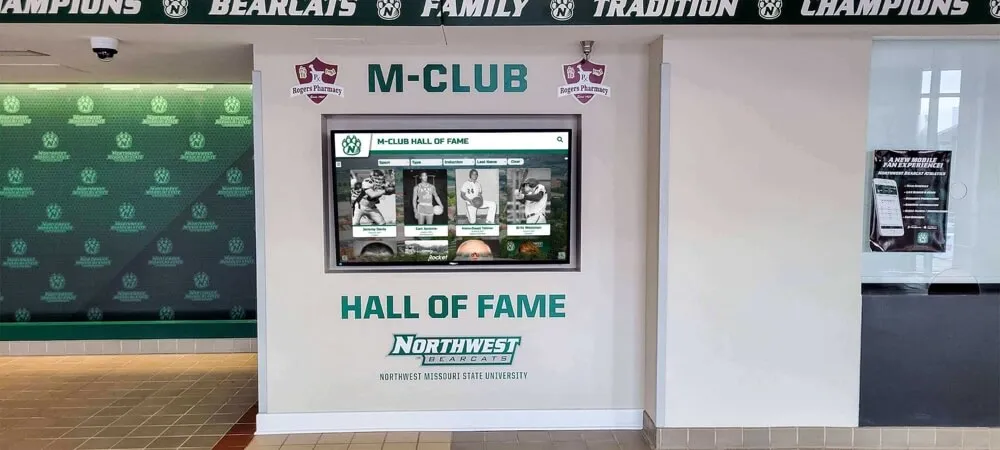
Engaging Community in Championship Celebration
Extending championship recognition beyond school walls amplifies celebration impact while building stronger community connections.
Local Media Partnerships
Collaborate with local media to maximize championship recognition visibility throughout communities.
Media Engagement Strategies:
- Press releases distributed immediately following championships
- Media interview opportunities with coaches and athletes
- Feature story pitches highlighting unique championship stories
- Photo and video asset sharing for media coverage
- Social media collaboration amplifying recognition content
- Documentary or special coverage partnerships
- Regular season follow-up stories about championship impact
Business Community Recognition
Local businesses often eagerly participate in championship celebration when approached with structured opportunities.
Business Partnership Approaches:
- Window display congratulations in downtown business districts
- Championship recognition at sponsored facilities or scoreboards
- Restaurant and retail celebration events honoring teams
- Advertising campaigns featuring championship achievements
- Sponsorship of recognition events or displays
- Discount programs for championship team members and families
- Championship banner or poster distribution throughout community
Social Media and Digital Engagement
Leverage digital platforms to extend championship celebration reach far beyond physical recognition displays.
Social Media Strategies:
- Championship announcement posts with photos and key details
- Video highlight clips distributed across platforms
- Individual athlete spotlight series throughout championship celebration
- Behind-the-scenes content from practices and preparation
- Community reaction and engagement content
- Countdown content building toward formal recognition events
- Alumni engagement encouraging championship congratulations
- Hashtag campaigns unifying championship conversation
Digital Content Distribution:
- Championship profiles on school athletic websites
- Email communications to alumni highlighting championships
- Digital yearbook integration
- Mobile app notifications celebrating achievements
- Video content on school YouTube channels
- Photo galleries on school social media
- Interactive timeline updates showing championship journey
Schools effectively implementing digital trophy case solutions can easily extend championship content across multiple platforms simultaneously, maximizing recognition reach and impact.
Preserving Championship Legacy for Future Generations
Effective championship recognition extends beyond immediate celebration to long-term legacy preservation that inspires future athletes.
Historical Archive Development
Systematic championship documentation creates institutional memory preserving athletic tradition across generations.
Archive Components:
- Chronological championship databases documenting all fall sports titles
- Decade-by-decade program evolution narratives
- Coaching history connecting championships to program leadership
- Alumni success stories linking championships to life achievements
- Facility improvement history supported by championship success
- Community support documentation showing broader impact
- Media coverage archives preserving championship moments
Inspiring Future Athletes
Championship recognition programs should explicitly connect past achievements to current athlete motivation.
Inspiration Strategies:
- Display placement ensuring daily exposure for current athletes
- Pre-season viewings of championship highlights and stories
- Freshman orientation introduction to championship tradition
- Goal-setting sessions referencing championship standards
- Alumni mentorship connecting current athletes with championship alumni
- Championship culture messaging in practices and team meetings
- Visual reminders in locker rooms and training facilities
Building Sustainable Recognition Systems
Create championship recognition programs that remain viable and effective across years and leadership transitions.
Sustainability Factors:
- Simple content management requiring minimal staff time
- Clear responsibility assignment for recognition updates
- Adequate budget allocation for ongoing maintenance
- Technology platform reliability and vendor support
- Community engagement maintaining recognition enthusiasm
- Regular assessment and improvement processes
- Documentation enabling smooth transitions during staff changes
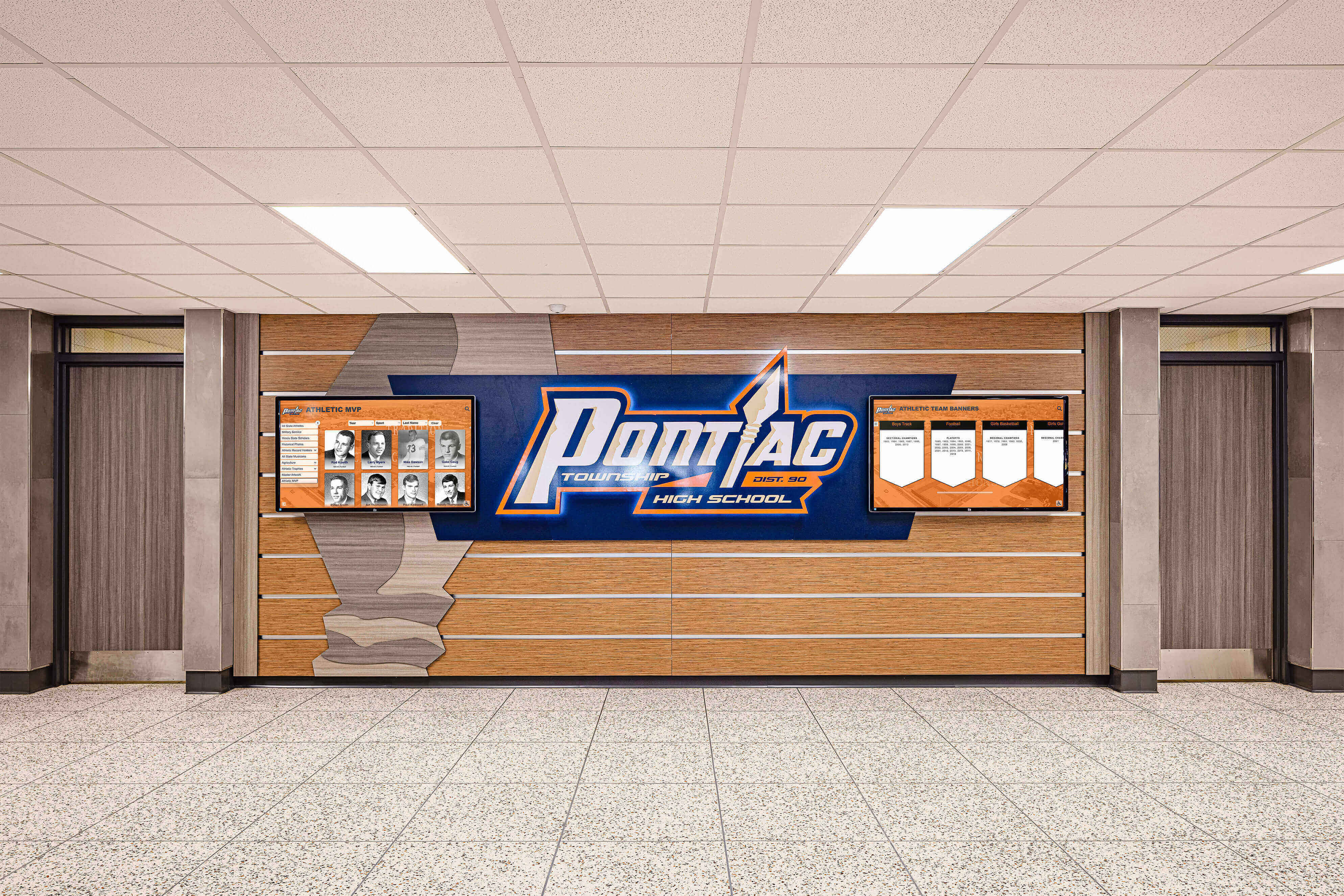
Measuring Championship Recognition Program Success
Evaluating recognition effectiveness helps justify investment while identifying improvement opportunities.
Quantitative Success Metrics
Track measurable indicators including:
- Display engagement frequency and duration
- Website traffic to championship content pages
- Social media reach and engagement rates
- Recognition event attendance
- Media coverage quantity and quality
- Community participation in celebrations
- Alumni engagement with championship content
Qualitative Impact Assessment
Gather feedback revealing recognition’s motivational and cultural effects:
Student Athlete Perspectives:
- Surveys assessing whether championship recognition influences motivation
- Focus groups exploring how recognition affects goal-setting
- Athlete feedback about meaningful recognition elements
- Senior athlete reflections on championship celebration importance
Coach and Staff Observations:
- Program culture changes following championship recognition
- Recruiting advantages gained from visible championship tradition
- Community relationship improvements
- Overall satisfaction with recognition approaches
Community Feedback:
- Parent perspectives on championship celebration
- Alumni engagement with recognition programs
- Local business and community leader input
- Media representatives’ views on recognition accessibility
Conclusion: Honoring Championship Excellence
Fall sports state championships represent extraordinary achievements deserving recognition that matches their significance. These championships result from years of athlete dedication, coaching excellence, family support, and community investment. They create memories that participants treasure throughout their lives while building institutional traditions that connect generations of students, athletes, and community members.
Modern digital recognition solutions ensure that championship celebration extends far beyond brief moments of triumph. By combining unlimited recognition capacity with rich multimedia storytelling, intuitive interactivity, and comprehensive content management, these platforms create lasting value across multiple dimensions: honoring every team member’s contribution with depth impossible through traditional plaques, inspiring current athletes by making championship tradition visible and aspirational, demonstrating program excellence to prospective athletes and families, strengthening alumni connections through ongoing recognition and engagement, and preserving institutional history for future generations.
The transition from traditional trophy cases and simple championship banners to comprehensive interactive recognition represents more than technological upgrade—it reflects evolved understanding of how effective recognition honors achievement while inspiring continued excellence. Every fall sports state championship becomes part of an ongoing story about dedication, teamwork, and achievement that motivates current students, attracts talented recruits, and strengthens institutional culture around athletic excellence.
Schools ready to transform fall sports championship recognition should begin planning today. Document existing championships comprehensively. Establish systematic processes for celebrating current and future championships. Evaluate technology platforms selecting solutions designed specifically for athletic recognition needs. Engage stakeholders building broad support for recognition investment. And commit to sustainable workflows ensuring recognition remains current and relevant for decades to come.
Solutions like Rocket Alumni Solutions provide comprehensive platforms combining proven technology, intuitive management, and dedicated support specifically designed for schools celebrating athletic achievement. From initial planning through years of ongoing use, the right technology partner transforms recognition from administrative task into celebration centerpiece that truly honors and inspires excellence.
Ready to create fall sports championship recognition worthy of these exceptional achievements? Modern digital recognition displays provide proven solutions honoring athletic excellence while building program culture where achievement flourishes. Your state champions earned their titles through years of dedication—they deserve recognition that matches their commitment and inspires the next generation to pursue similar excellence.




































